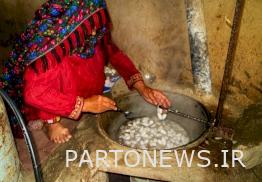Traditional silk-slaughtering, the art of the Razujrglan people

Caring for silkworms is the maintenance of silkworms and the conversion of silk cocoons into silk threads by hand. They are poured and made into silk threads with the help of rotating machines and with the help of hands, and they are used for precious silk fabrics and silk carpets and so on.
This craft is very prosperous and abundant in Raz and Jorglan-Gifan-Rastqan region and has met the needs of the region. Work and lack of adequate facilities are in danger of extinction.
Silk is one of the animal fibers and is used to produce beautiful, delicate and valuable handmade fabrics. A fiber is a protein obtained by freezing the substances secreted by silkworms and is composed of two parallel filaments bound together by a viscous substance called gum.
Silk yarn: Silkworms are bred to produce cocoons and the cocoons are used for silk-killing. The main product of the weaving process is silk cocoon from which silk fibers are extracted. Silk fibers have a very beautiful luster and have various and important applications in handicrafts as a raw material. For example, in textiles and textiles, precious and delicate fabrics such as silk, gold and velvet, valuable silk carpets and yarn are used for beautiful needlework and so on.
Noghandari silkworm breeding is called noghandari and in the past, noghandari and silk weaving were popular as one of the basic and important handicrafts in Iran.
North Khorasan province in terms of climatic and climatic conditions with a long history in the production of agricultural products has a special share of the country’s products such as wheat, barley, silk cocoons, oilseeds and horticultural products, so a large share of the province’s employees directly And are indirectly employed in the agricultural sector and its conversion industries.
Nougat:
Breeders produced silkworm eggs from silkworm moths in the spring, and in the new year, in May, they opened the worms in a warm place, and every family that had a place to raise worms would do so and build a place for the silkworm and its cocoon. And that room was clean and whitewashed with plaster.
After the worms hatched from their eggs, they gradually used the leaves of the fresh berry branches to feed the silkworms and grow them. In the last stage of leaf-eating, the worms grow enough and close the cocoons around themselves, at which time they collect and clean the cocoons.
A silkworm needs a suitable, clean, odorless, warm, berry-free place to grow silkworms. Care should be taken at all times, silkworms should avoid the slightest harm, including animals and insects such as ants, even breeders and family members should not use emollients and fragrances because the same smell of cream and perfume will cause the death of all worms.
The first steps are like waking up, which keeps the egg warm and causes the worm to come out of the egg. Stage sleeps up to five stages and reproduces each time they fall asleep. In the last sleep, it gradually shows that it is time to close the cocoon.
After stacking, the berries are fed on it for 30 to 40 days, and after a week, the silkworms cocoon and collect at this stage.
Silkworm:
After the silk cocoons are produced, they are first cleaned. In order to prepare silk threads, the life of the cocoon must be cut before reaching the pupal stage and it must be suffocated to prevent it from turning into a moth. For this action, cocoons are usually spread in the sun for one to two days in this area or this action is done by steaming.
Then the silk cocoons, which are called peaks at this stage, are poured into the cast-iron boiling pots of “Patil” locally called Kazan (a hemispherical container) and the silk fibers of “Poopak” are separated from the cocoons on a twisted spool and from there to the wheel. It carries a silk called a “feather” (butterfly), which causes the silk threads to accumulate on the boiler water.
At this time, the above wires are taken from the boiler and pass through a metal that has three twists with a diameter of about 2 cm. It is then passed over a wooden spool and twisted around the axis of a machine that rotates by hand, also called “Chaldeans” in the Turkmen dialect. The raw silk prepared in this way is rinsed with cold water and then dried.
The yarn that is prepared in this way has some dried pupae and is attached to it in such a way that it needs to be spun and its dirt removed and a good yarn is obtained.
Silk:
The spun yarn in the spinning machine is a little rough and is spun again in another machine called a wheel to reduce its roughness. After the spinning machine, it is the turn of the spinning machine, which strengthens the silk threads. In this device, the yarns are spun again and prepared for dyeing. Silk spinning machine A device for spinning silk yarns that consists of several large and small cycles. The wheel by which silk is spun. After the threads have hardened, the butterflies cross into a coil, and then turn white by the ashes of the mulberry tree and the white sesame plant, and are dyed with chemical dyes, walnut bark and pomegranate bark.
The most common colors used in silk weaving are blue, red, green and black. In the past, natural colors such as rhubarb, walnut skin, pomegranate skin, etc. were used, which have high stability, but today, low-durable chemical dyes are used.
The techniques and skills of weaving, silk weaving and silk weaving have been registered in the list of national works of the country with the number 2187.

